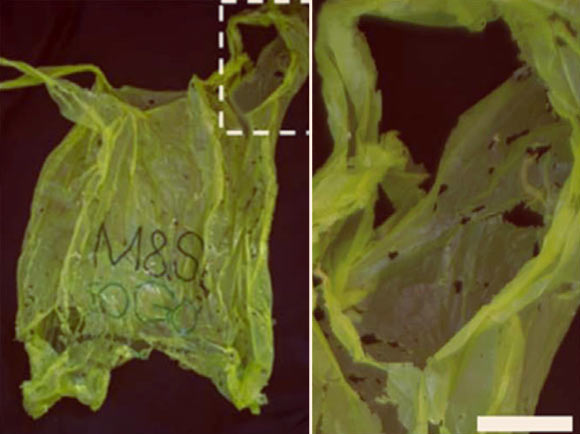Plastic polymers are ubiquitous in our lives, and while their resilience makes them ideal for a variety of uses, finding means to effectively dispose of them represents a major challenge. Recently, a variety of plastivore insects have been discovered that possess the remarkable ability to consume and rapidly degrade petro plastics. Focusing on the caterpillar larvae of the greater wax moth (Galleria mellonella) — known as wax worms — and low-density polyethylene, scientists explored how much plastic is consumed, the relative contributions from the insect and its microbiome to the biodegradation process, and the impacts of plastic ingestion on larval fitness.
Polyethylene degradation by wax worms. Left: plastic bag after exposure to about 100 wax worms for 12 hours; Right: magnification of the area indicated in the image at left. Image credit: Bombelli et al, doi: 10.1016/j.cub.2017.02.060.
Plastics play a fundamental role in modern life, but their resistance to biodegradation makes them very difficult to dispose of.
In 2017, biologists demonstrated that the caterpillars of the greater wax moth can degrade polyethylene plastic.
Polyethylene is the world’s most commonly manufactured plastic, with over 100 million tons of polyethylene produced globally each year.
This plastic is chemically resilient, which makes it resistant to decomposition and can take decades or even hundreds of years to fully degrade.
“Around 2,000 wax worms can break down an entire polyethylene bag in as little as 24 hours, although we believe that co-supplementation with feeding stimulants like sugars can reduce the number of worms considerably,” said Dr. Bryan Cassone, a biologist at Brandon University.
“However, understanding the biological mechanisms and consequences on fitness associated with plastic biodegradation is key to using wax worms for large-scale plastic remediation.”
Utilizing a suite of techniques spanning animal physiology, material science, molecular biology and genomics, Dr. Cassone and colleagues studied the interesting relationship between wax worms, their bacterial microbiome, and their potential for large-scale plastic biodegradation, as well as the possible impacts on wax worm health and survivability.
“This is similar to us eating steak — if we consume too much saturated and unsaturated fat, it becomes stored in adipose tissue as lipid reserves, rather than being used as energy,” Dr. Cassone said.
“While wax worms will readily consume polyethylene, this research also shows that this ultimately ends in a quick death.”
“They do not survive more than a few days on a plastic-only diet and they lose considerable mass.”
“However, we are optimistic that we can formulate a co-supplementation that not only restores their fitness to natural levels but exceeds it.”
The researchers identified two ways in which wax worms could contribute solutions to the ongoing plastic pollution crisis.
“Firstly, we could mass rear wax worms on a co-supplemented polyethylene diet as part of a circular economy,” Dr. Cassone said.
“Secondly, we could explore the re-engineering of the plastic biodegradation pathway outside the animal.”
“As a bonus benefit, the mass production of wax worms would also generate a substantial surplus of insect biomass, which could represent an additional economic opportunity in aquaculture.”
“Our preliminary data suggests that they could become part of a very nutritious diet for commercial food fishes.”
The authors presented their findings today at the Society for Experimental Biology Annual Conference in Antwerp, Belgium.
_____
Bryan J. Cassone et al. Plastic Biodegradation by Insects. SEB 2025, abstract # A17.4
